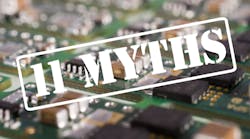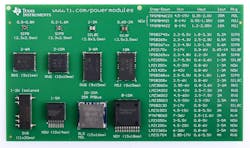11 Myths About Power Modules
This article is part of TechXchange: Power Supply Design
What you’ll learn:
- Power modules’ role in current and future switching power supplies.
- How power modules can save you design time.
- The differences between module vs discrete implementations.
“I love overcomplicating my design process”—said no engineer ever. While never intentional, the number of roadblocks that stand in the process of selecting a power-management solution can be overwhelming.
Perhaps surprisingly, power modules might be the semiconductor industry’s answer to some perennial problems. With advanced component integration, optimization, and performance, modules deliver a power solution that makes the design process more straightforward than ever.
But, alas, the value of a power module faces the same scrutiny as a certain circa-2007 pocket-sized device, introduced by a certain turtlenecked CEO, that could surf the web, play a million songs, and call people. Some skeptics still see modules as inflexible, while others think they’re just a fad. Join me in examining the outcries and blanket statements as I address 11 common myths about power modules.
1. Power modules don’t save that much time. You know what components will suit your design best.
Engineers all know that feeling of combing through datasheet after datasheet to no avail. We know the feeling of seeing a 10-week lead time on a resistor that had 100 units in stock the day before. We know the feeling of running our “final” subsystem tests, only to find out that a resistor wasn’t soldered on correctly.
Thankfully, the power-module manufacturing process itself eliminates most of these headaches. Using a power module greatly reduces the task of sourcing components and running simulations to characterize your power stage, leaving you free to spend time solving the problems that matter most to you.
2. Power modules are only applicable for more generic use cases. Discrete solutions are always better because you can optimize them for any use case.
A fully integrated solution isn’t the same as a solution that aims to please everyone. In fact, part of what makes power modules so easy to use is that they’re often derived from discrete solutions already catering to specific use cases. For example, if your favorite discrete solution is optimized for low noise, fast transient response, or an extended operating temperature, there likely exists a power module that meets a very similar specification.
In addition, many modules ship in pin-to-pin families that span specific output current or voltage ranges. For example, the TPSM41615 and the TPSM41625 power modules are stackable 15- and 25-A solutions that share the same footprint, so they cover a range of currents from 15 to 50 A (Fig. 1). Rather than being stuck with some generic one-size-fits-all solution, you’re empowered with the ability to choose a device suited to meet your system requirements, and avoid a significant redesign if something changes.
3. Power modules don’t have any inherent benefits outside of integration. Discrete solutions don’t lock you into arbitrary optimization or require the use of certain passives.
When you choose to design with power modules, you can rest easy knowing that your solution of choice was hand-tailored by the industry’s best power, packaging, and layout experts. Beyond the datasheet, power-module manufacturers also give designers simulation tools and characterization data. By selecting a power module, you have gained access to a fully characterized power supply, which means you don’t have to spend additional time figuring out if a device is right for you.
Using a discrete converter would be like having a student driver compete in Formula 1 racing. Why put crossing the finish line in jeopardy when a module guarantees you a place on the podium?
4. Power modules use components that aren’t qualified for tougher applications.
If your power supply will be soaring 30,000 feet above ground, you’ll want to be sure the air temperature doesn’t cause it to malfunction. Similarly, in an operating theater, interference from a supply can result in noise or distortion in outputs from imaging equipment.
To mitigate that, you could use a discrete converter operating with an extended temperature range or one that’s compliant with Comité International Spécial des Perturbations Radioélectriques (CISPR). However, this still requires the selection and sourcing of qualified components to meet those specifications.
Thankfully, power modules come pre-validated to meet said requirements, which gives you a plug-and-play solution right out of the box. For electromagnetic-interference (EMI)-sensitive applications, EMI-tested power modules like the TPSM63606 include integrated passive components that have been laid out to meet strict requirements.
5. Power modules are expensive.
It’s easy to look at something smaller and more efficient and think of the associated price tag, or assume that ease of use comes at a premium. Thankfully, modules aren’t laptops or smartphones.
First and foremost, the nominal price gap between power modules and discrete solutions is slowly reaching parity. When you look at the cost of sourcing, qualifying, and laying out passive components that would be already integrated in a module, it becomes clear that the cost of doing so—in addition to selecting and sourcing external components—comes fairly close (and in some cases even exceeds) the cost of simply choosing a power module in the first place.
Another often overlooked factor is the potential cost of things going wrong. The “premium” associated with power modules is nominal compared to the cost of recall, requalification, retesting, and more.
6. Power modules won’t help you save space on the board.
Power modules can be smaller than a discrete solution in embedded packages, which directly embeds a die into a printed-circuit-board (PCB) substrate as depicted in Figure 2, thus allowing the actual substrate area to host external components such as the inductor. This integration effectively removes the converter stage from the overall X-Y calculation, yielding a solution size that’s impossible to replicate using a discrete solution on its own.
7. Power modules are too tall.
A discrete solution on its own is almost never the source of a significant increase in solution height. In fact, most height increases are actually attributable to the inductor, as it’s almost always the tallest component in your power-management system. Because power modules are typically optimized for solution size, efficiency, and height, there’s a general guarantee that you can expect a module height as short, if not shorter, than a discrete implementation.
8. Power modules aren’t optimized for efficiency because power-module manufacturers don’t consider factors outside of inductor selection.
It’s understandable to think that because the inductor is already pre-selected and integrated, a power module trades high efficiency for ease of use. On the contrary, power modules are designed to provide the highest-efficiency solution with the added bonus of integration.
Since discrete efficiency curves often rely on switching field-effect transistors, thermal dissipation, and heuristic external component selection, efficiency as a whole actually has multiple contributing factors. Power modules work to take these external factors (that often trip up even the best designers) and deliver the easiest solution possible while maintaining or even exceeding the efficiency standards you’ve come to expect.
9. Compared to leading discrete solutions, power modules are a few generations behind.
Integrated-circuit (IC) manufacturers are always looking for ways to simplify the design and manufacturing process for electronics. As I mentioned previously, the industry’s leading discrete solutions often serve as the source of inspiration for the latest and greatest power-module solutions.
Beyond the die, though, IC designers also are pushing boundaries in packaging, component placement, and process technology. The latest and greatest features, typically only available through discrete converters, are now deliverable in the smallest, easiest-to-use, and most efficient form factor possible.
10. You don’t need power modules—you can easily replicate the power-module design yourself.
When looking at solution size by length and width, the adventurous designer might be inclined to think that they can come up with an arrangement of components to create a final power supply that saves as much board space as humanly possible. But the construction of many modules isn’t easily replicable by hand.
One example of that is how some modules have components embedded directly into the substrate on which the die sits. Another example is the overmolding of the die and integrated components to improve their adhesion to the leadframe. These manufacturing innovations are just some of the ways packaging engineers can shave millimeters off your design.
11. Power modules are just a fad.
Although I don’t have access to a crystal ball, one thing remains clear: Design challenges will only get tougher (and take longer) to solve as requirements become more stringent. Every day, greater numbers of power designers shift toward using power modules because they reduce size, provide more optimized efficiency, and offer the richest feature sets. The resulting benefits drastically outweigh the risks associated with venturing out on your own in search of the right power solution.
Moreover, semiconductor manufacturers are continuously monitoring power trends and application requirements, all with the aim of reducing the frequency of roadblocks in your design and helping you get your product to market faster than ever.
Conclusion
You demanded an efficient, robust, easy-to-use power solution—the industry delivered. By implementing a power module, you are effectively embedding the expertise of the industry’s best within your design. While acknowledging that there’s never a one-size-fits-all power solution, I hope when reading this article, you can see that modules have a place in your current and future switching power supplies.
Read more articles in TechXchange: Power Supply Design


